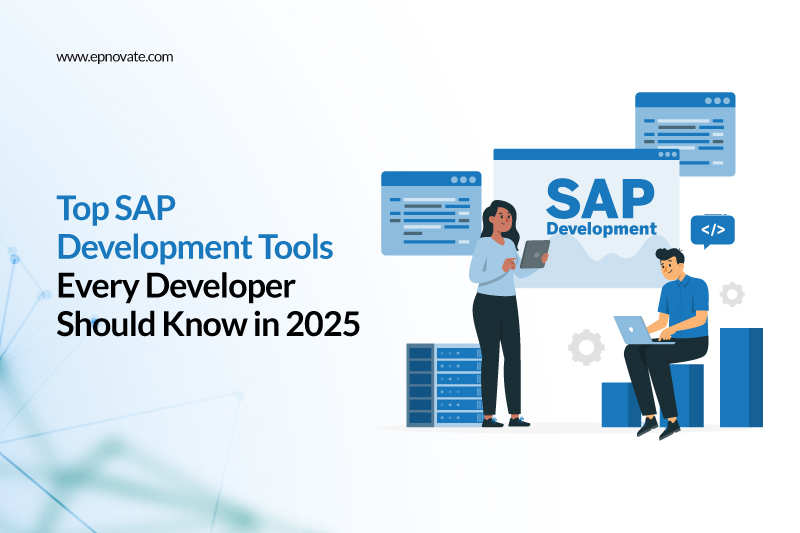Top SAP Development Tools Every Developer Should Know in 2025

SAP is one of the most used software platforms by large businesses across the world. It helps manage everything—from finances and human resources to inventory and customer service.
But to build smart and useful SAP apps, developers need the right tools.
In 2025, SAP tools are getting better, faster, and more developer-friendly. Knowing which tools to use can help developers save time, avoid errors, and build apps that meet real-world needs.
Let’s look at the top SAP development tools every developer should be familiar with.
Why Developers Need Specialized SAP Tools in 2025
SAP systems are not basic software programs. They are complex, with many moving parts. You may need to connect different departments like sales, inventory, and accounting.
You also need to follow data safety rules and build apps that are easy to scale and update.
In 2025, businesses expect apps that work smoothly across locations and devices. Developers need to build apps that are secure, flexible, and fit well with SAP’s core system. That’s why using the right development tools is so important.
These tools help you:
- Write and test code faster
- Work better in teams
- Avoid breaking the system
- Make sure the app works well in different countries or departments
- Keep data private and secure
Many companies rely on a SAP development company to choose and use these tools effectively, especially when custom development is needed.
Top SAP Development Tools to Master in 2025
Here are the most important tools SAP developers should know this year:
1. SAP Business Application Studio (BAS)
This is SAP’s modern cloud-based development environment. It looks and feels like Visual Studio Code and is built for building SAP apps easily.
- Why use it: It supports many types of apps, including Fiori, CAP, and full-stack apps.
- Top features: Built-in templates, Git integration, terminal access, and cloud debugging.
2. ABAP Development Tools (ADT)
This tool works inside Eclipse and is used for writing ABAP code, the core language of SAP.
- Why use it: Great for backend developers who need to write logic and manage SAP systems.
- Top features: Syntax checks, version history, testing tools, and easier navigation.
3. SAP Fiori Elements and Fiori Tools
Fiori is the design system used to build user-friendly apps in SAP. Fiori Elements lets you create apps with less coding. Fiori Tools help you preview, edit, and test these apps.
- Why use it: Build consistent and clean user interfaces quickly.
- Top features: Page templates, annotations, smart filters, and easy testin
4. SAP Cloud Application Programming (CAP) Model
CAP lets you build apps using simple languages like JavaScript or Java while staying connected to the SAP system.
- Why use it: Helps you build full apps quickly, especially when using SAP BTP.
- Top features: Data modeling, service generation, and reuse of services.
5. SAP Integration Suite
This helps you connect SAP systems with other tools, cloud services, or partner apps. It’s great for building APIs or linking data across platforms.
- Why use it: Modern businesses often use more than one system.
- Top features: API design, process flows, adapters, and monitoring dashboards.
6. SAP Mobile Services
This is part of SAP BTP and is used to create mobile apps for SAP systems.
- Why use it: Healthcare workers, field agents, or warehouse staff often need access on the go.
- Top features: Offline sync, mobile SDKs, secure login, and push notifications.
How to Choose the Right SAP Tool as a Develope
Not every SAP project is the same. Some need web apps. Others require deep backend logic or mobile access. When picking tools, think about:
- Project type: Frontend, backend, or both?
- Team size: Are you working solo or with others?
- Target users: Office users or mobile workers?
- Integration needs: Do you need to connect other platforms?
- Learning curve: Are you new to SAP tools or experienced?
Many developers also look to a trusted SAP services company for advice on tool selection, training, and setup. They help teams choose the best tools for speed, quality, and long-term support.
Future Trends in SAP Development Tools
SAP development is changing fast. Here are some trends to watch in 2025:
- Low-code tools: SAP is adding tools that let people build apps with less coding, like SAP Build Apps. This helps non-developers get involved.
- AI assistance: New tools may include built-in AI to help write code, fix bugs, or suggest improvements.
- More open-source: SAP is working more with open-source tools and communities. Expect more flexibility.
- Better testing support: Testing tools will become stronger, helping developers check apps without needing full system access.
- Cloud focus: Almost all SAP tools now support or require cloud use. Expect cloud-first apps to be the new normal.
Conclusion
SAP development tools are now smarter, faster, and more connected to the real needs of users and developers.
Whether you’re working on user interfaces, backend logic, mobile apps, or integration, there’s a tool designed to help you do it better.
Learning these tools not only boosts your skills but also helps your business deliver better SAP solutions. And if you feel stuck or need extra support, working with an experienced partner like Epnovate can guide you through.
Knowing the right tools is step one. Using them well is how you build powerful SAP apps that truly help people.
Recent Posts
- 10 SAP Line of Business Solutions Empowering Digitally Transformed Enterprise Operations
- Choosing the Right SAP Implementation Partner: What Businesses Need to Know
- How to Future-Proof Your SAP ERP
- SAP Operations Continuity: 5 Priorities You Need to Embrace Today
- Introducing The First-of-Its-Kind SAP HANA Community Cloud

